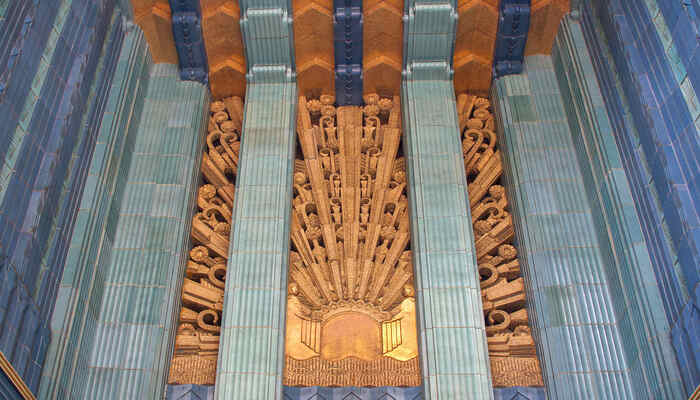Manhattan of Dubai: World’s First-Ever Bugatti Residences
Table of Contents
Bugatti, the renowned French luxury car brand, has partnered with Binghatti Properties, a leading real estate developer in the UAE, to introduce a groundbreaking concept—the world's first Bugatti Residences. This collaboration will redefine luxurious living with a 48-storey skyscraper in Dubai, featuring innovative car lifts that go from the garage directly to penthouse levels.
These Residences will mark Bugatti's debut in residential real estate and will be the first residential building bearing the car manufacturer's prestigious name. Located in Dubai's Business Bay area, the Bugatti Residences will boast a sleek design with balconies on every floor. It will offer 171 apartments known as Riviera Mansions and 11 exclusive Sky Mansion Penthouses.
An Overview of Bugatti Residences - The Epitome of Luxury Living
The Bugatti Residences will offer a luxurious living experience with 182 apartments spanning 42 stories. Residents can choose from two-, three-, or four-bedroom penthouses, each named after iconic destinations like Canes, St.Tropez, and Monaco. The residences will feature amenities inspired by the Riviera lifestyle, including a Riviera-inspired beach area, a secluded pool, a relaxing jacuzzi spa, a top-notch fitness centre, an exclusive chef’s table dining experience, personalised valet services, and access to private members club.
Each apartment in this magnificent skyscraper will have a unique shape and access to a curved balcony and rooftop pool. The penthouses will benefit from the two garage-to-penthouse car lifts, allowing owners to drive their vehicles directly into their apartments, similar to Bentley’s Miami skyscraper. The design will incorporate the aesthetic of the French Riviera throughout the building, creating an extravagant living experience for residents.
Bugatti Residences draws inspiration from Bugatti's automotive aesthetics and will incorporate them into its architectural elements. This will create a distinctive fusion of style, functionality, and comfort, setting a new benchmark for luxury living. Here are the architectural elements that deserve a special mention for their innovative design and functionality:
1. Sleek and Dynamic Design
The exterior of Bugatti Residences will reflect Bugatti’s iconic design language, characterised by sleek lines, aerodynamic curves, and a sense of dynamic movement. This aesthetic will be translated into the building’s facade, creating a visually striking presence in the Dubai skyline.
2. Premium Materials
Like Bugatti’s meticulous attention to detail in crafting high-performance cars, the architectural elements at Bugatti Residences will be crafted using the best quality materials. From luxurious finishes to state-of-the-art fixtures, every aspect of the building will exude elegance and quality synonymous with the brand.
3. Functional Innovations
Contrary to a form-follows-function approach, the design of Bugatti Residences prioritises functionality over aesthetics. Each architectural element serves a specific purpose beyond mere visual appeal. Take, for instance, the curved balconies that will provide extensive outdoor spaces and offer residents panoramic views of the cityscape.
4. Integrated Technology
Bugatti’s commitment to innovation extends to smart technology integration within the residences. From automated lighting and climate control systems to advanced security features, residents will experience the convenience and comfort of modern living.
5. Efficient Space Utilisation
The layout of each apartment and common area is carefully planned to maximise space utilisation while maintaining a sense of openness and luxury. Functional areas such as private spas, fitness centres, and car lifts are also integrated into the design, improving the residents' living experiences.
Also Check out: Exploring the 8 Most Innovative BIM Projects in the Middle East
Architectural Marvel: Design and Engineering of Bugatti Residences
Binghatti has translated Bugatti's renowned craftsmanship and artistry from the automotive industry into real estate through distinctive architecture marked by bold and intricate designs. This collaboration reflects continuous design innovation and engineering progress while honouring the heritage of both family-founded brands. Together, they aim to create a residential masterpiece that embodies Bugatti's philosophy and design essence.
1. Exterior Design
The exterior design of Bugatti Residences will be majestic and one-of-a-kind. It will showcase the innovative use of architectural design and engineering capabilities at its best. Inspired by Bugatti’s automotive aesthetics, the building's facade will feature dynamic curves, clean lines and a modern yet timeless visual flow. The use of high-end materials will add a touch of luxury, while the integration of glass elements will allow for breathtaking views of the surrounding cityscape. One of the standout features will be the curved balconies that wrap around the building, offering residents expansive outdoor spaces and panoramic views. The design will enhance the building’s visual impact and provide a seamless indoor-outdoor living experience.
2. Interior Design
Inside Bugatti Residences, attention to detail will be evident in every aspect of the interior design. Luxurious finishes, custom-designed fixtures, and high-end materials will create a sense of luxury and refinement. Open floor plans and floor-to-ceiling windows will maximise natural light and create a sense of spaciousness.
The interior spaces will be designed to blend functionality with aesthetics. Smart technology integration will allow for automated systems that enhance the convenience and comfort of residents. From private spas and fitness centres to elegantly appointed common areas, every space is crafted to elevate the residents' lifestyle.
Blend of Architecture and Engineering: Bugatti interiors will be much more than just furniture creation. They will be about sculpting pieces of art that echo the brand’s rich legacy. Every item in the Bugatti home will mirror the spirit that propels Bugatti’s sports cars. Whether it’s tables, chairs, lighting fixtures, or sofas, the interior design ethos will revolve around precision, innovation, and a profound sense of aesthetics.
Impeccable Craftmanship: Bugatti Interiors will epitomise impeccable craftsmanship through its unwavering dedication to precision and an unmatched level of attention to detail. Every piece will be carefully crafted, surpassing even the most stringent quality standards. The skilled artisans behind this will bring decades of experience and deep respect for the brand’s heritage to each masterpiece they create.
Luxury First Approach: The Bugatti home interiors will reflect luxury in every aspect. The materials selection will be meticulously created, featuring the finest quality exotic woods, premium leather, and cutting-edge materials. These materials will be chosen for their exquisite aesthetic and exceptional durability, guaranteeing these pieces endure the test of time.
Technology Used in Making This Luxurious Residence
1. Building Information Modelling (BIM)
BIM technology has been extensively used in the design and planning phases of Bugatti Residences, allowing detailed 3D modelling and virtual simulations of the entire project, aiding in coordination, visualisation, and efficient decision-making.
2. BIM software for Structural Engineers
Engineers rely on robust software tools for structural analysis and design optimisation. These tools help ensure that the building’s structural integrity meets the safety standards while accommodating complex architectural features.
3. Construction Techniques
Advanced construction techniques, such as prefabrication, modular construction, and innovative formwork systems will improve efficiency, quality control, and on-site safety.
Also Check out: How BIM was Used to Ease the Construction of Abu Dhabi International Airport?
4. Smart Building Systems
Smart technology will be integrated into the design for enhanced functionality and convenience. This includes automated lighting, climate control, security systems, and digital connectivity managed through centralised control systems or smart home platforms.
5. Energy Efficient Solutions
Technology will be leveraged to implement energy-efficient solutions within Bugatti Residences, such as LED lighting, solar panels, and advanced insulation systems. These measures will impact and contribute to sustainable living practices.
6. Wellness and Entertainment
Technological advancements will be utilised to integrate wellness technologies like spa facilities, fitness centres, and digital entertainment amenities. These features will enhance the well-being of residents and offer recreational opportunities within the residential complex.
Importance of Technology in Designing Bugatti Residences
BIM and Computational Design offer an in-depth digital model of the project, allowing the design and construction team to visualise the integration of various systems or components. Here are the primary ways the BIM process and computational design can facilitate the design of Bugatti Residences.
1. Greater Efficiency and Reduced Project Duration
Leveraging the capabilities of BIM technology leads to a reduced design phase (pre-construction). BIM extends beyond traditional 3D modelling by incorporating a fourth dimension: time. The advantage of 4D BIM is evident in reduced construction duration, streamlined workflows, and overall process efficiency.
2. Interdisciplinary Coordination
Bugatti Residences will integrate various departments, such as Mechanical, Electrical, and Plumbing (MEP) systems. Using BIM, all the teams can efficiently coordinate these elements by developing a comprehensive digital project model. This will enable them to visualise the seamless integration of various components and systems and help them identify and resolve potential design and construction issues or conflicts before construction.
Also Check out: What Does a Computational Designer Do and How to Become One
3. Clash Detection
Developing BIM models will enable the design and construction teams to detect potential clashes among various building systems and components. This early identification will allow the teams to proactively resolve issues before construction begins, mitigating the risk of delays and costly reworks.
4. Saves Costs and Resources
BIM technology offers tools for calculating project estimates, providing architects and stakeholders with quick and accurate assessments of material, shipping, and labour costs. These estimates automatically update with revisions, giving a clearer picture of project costs and schedules compared to traditional methods. This saves valuable time and allows for more informed decisions on cost-effective materials and potential pre-fabrication options and reduces human errors and project delays.
5. Improved Communication and Collaboration
Implementing a BIM process creates a unified platform where all stakeholders can access and collaborate using the same project data. This enhances communication and teamwork among diverse teams, such as architects, engineers, contractors, and clients, and also helps reduce errors, conflicts, and project delays.
6. Higher Quality Results
Utilising BIM not only streamlines the design and construction process but also enhances the overall end product quality. The detailed calculations and precise modelling provided by BIM are key advantages that directly contribute to a higher standard of outcome.
Conclusion
The Middle East region has witnessed a significant rise in the adoption of BIM technology and Computational Design in recent years, leading to the development of numerous innovative BIM projects. BIM has played a pivotal role in the successful design and execution of these impressive structures. Its utilisation has allowed architects and engineers to visualise and refine their designs effectively while enhancing collaboration, reducing errors, and streamlining construction processes. With the Middle East continuously pushing the boundaries of innovation in construction and design, we can anticipate the emergence of even more exciting BIM projects in the future.
With the rising demand for BIM and Computational Design, it has become a must for architects and engineers to stay up-to-date with the latest technologies. If you want to become a part of designing futuristic architecture designs like the Bugatti Residences, it’s essential to upskill and explore courses in BIM and Computational Design. This will not only improve your chances of positioning yourself in leadership roles but also help you land global opportunities.
Novatr offers a holistic Master Computational Design Course for Real-World Application, featuring a specialised and relevant curriculum. It covers Computational Design and teaches 5+ software and 15+ plugins within 10 months. The course ends with a capstone project, allowing you to apply your knowledge effectively. Under the guidance of industry experts, you will gain practical experience with industry-relevant workflows. Elevate your career by mastering the art of designing efficient built environments using computational tools. Start upskilling today!
Visit our Resources page for more insights on computational design, software, careers, and the latest industry trends.
Frequently Asked Questions
1. How much does the Bugatti apartment cost in Dubai?
The price of the Bugatti apartments depend on the type of the unit chosen by the customer and the number of bedrooms in the apartment. A 2-bedroom apartment can start at AED 19,090,000 and reach up to AED 52,000,000 for a 4-bedroom one, while a penthouse starts at AED 130,000,000.
2. Who is the developer of Bugatti residences?
Bugatti residences is a major project developed by Binghatti developers. The construction commenced in 2024. However, the Bugatti residence completion date is not finalised, the residence is expected to open in 2027.
3. How many floors are there in the Bugatti Residence in Dubai?
Under development in the Business Bay, Bugatti Residence is a 48-storey residential building.

 Thanks for connecting!
Thanks for connecting!
.jpg)
%20(1).png)
%20(1).png?width=767&height=168&name=MCD%20B%20(Course%20Banner)%20(1).png)
.png)




-1.png)

